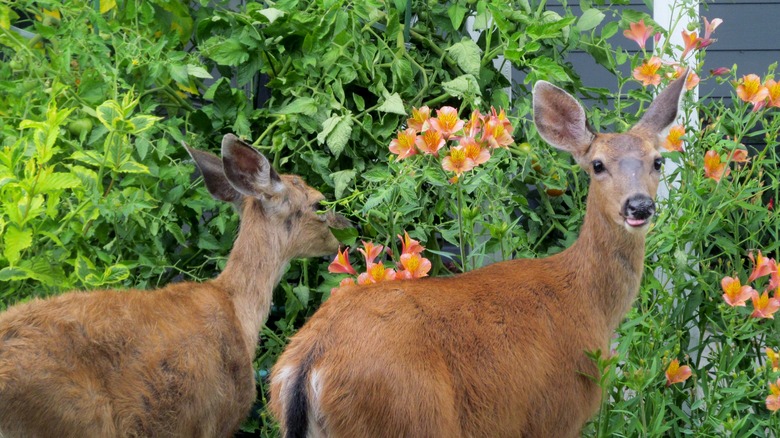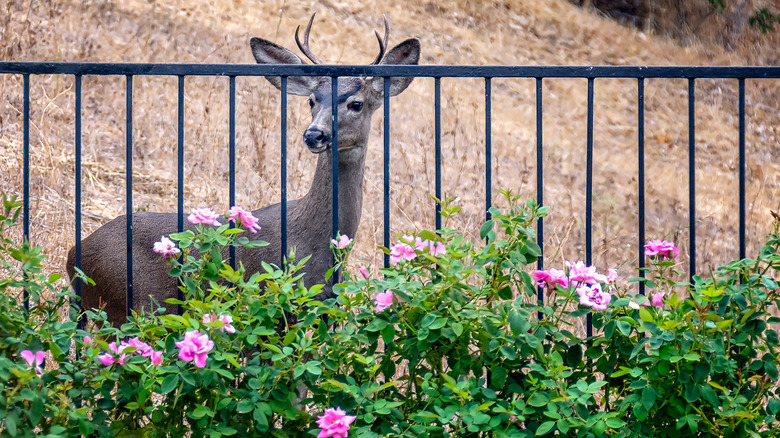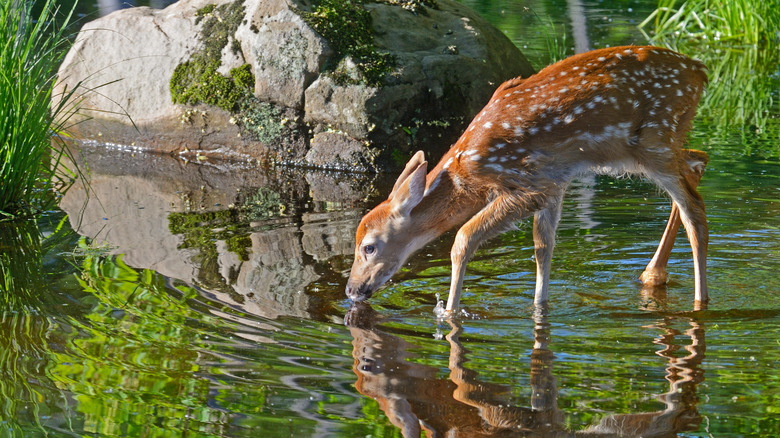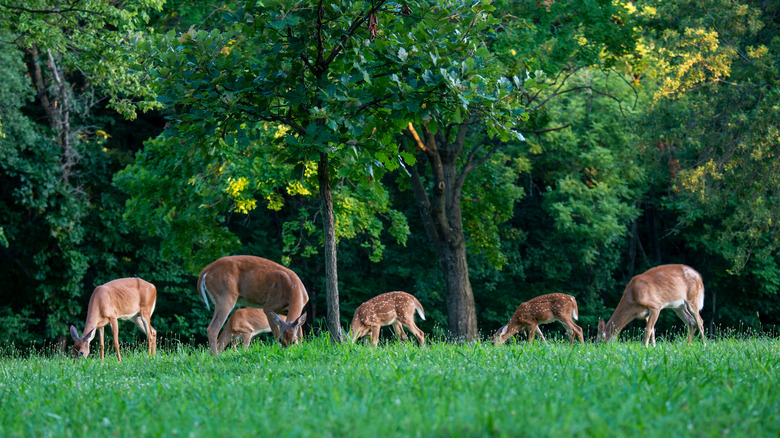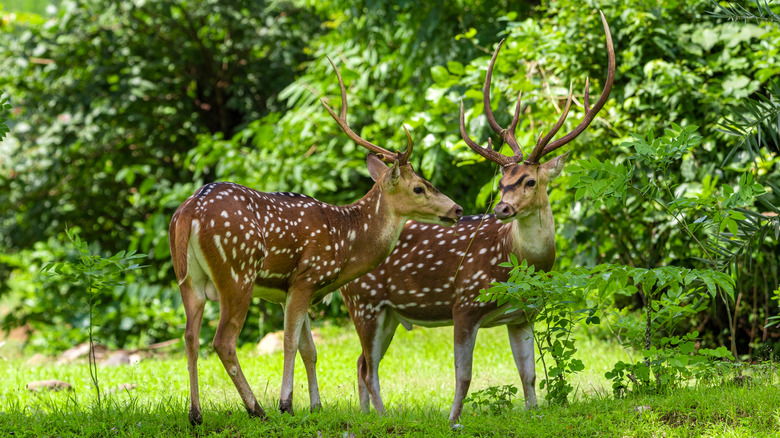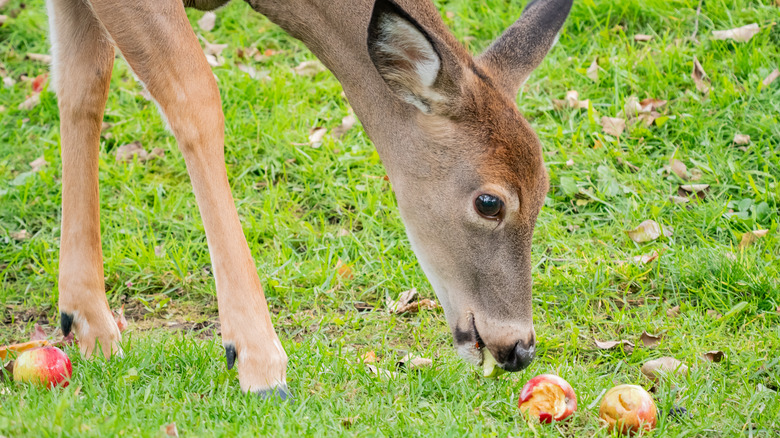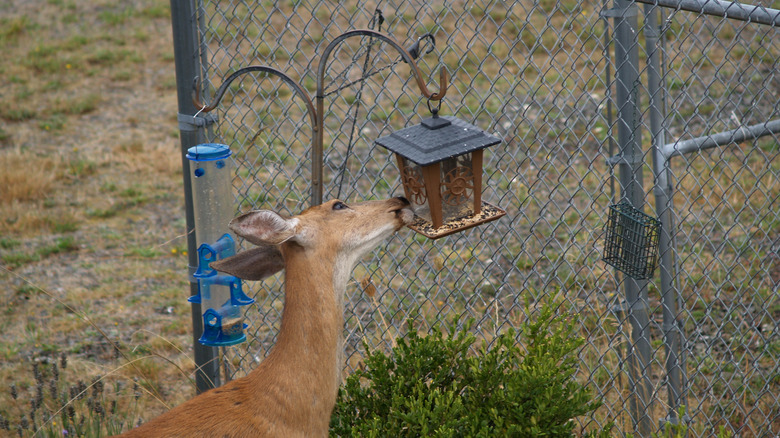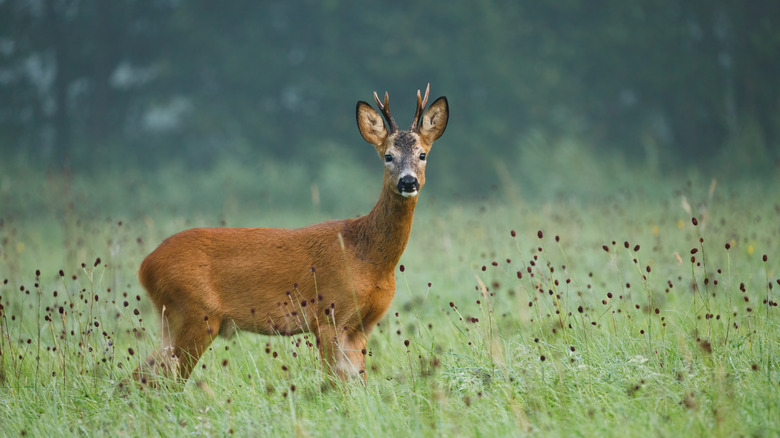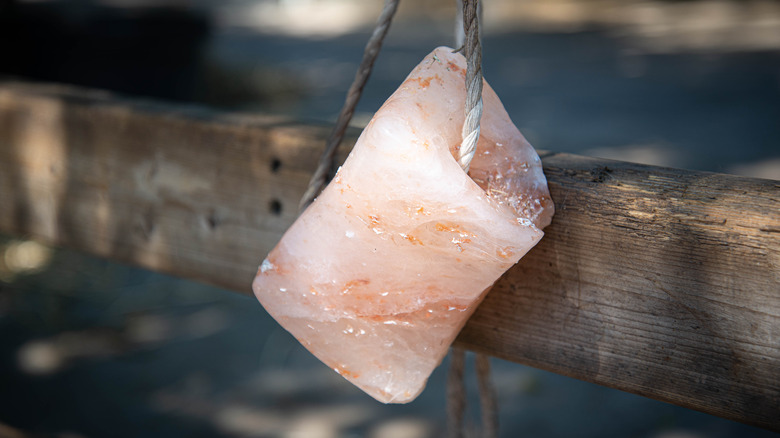How To Attract Deer To Your Garden
Deer are often not a welcome presence in gardens and backyards. This woodland animal typically likes to make a snack out of both crop gardens and flower beds, as well as other landscaping plants. As Bobbex notes, deer eat over 500 species of plants and tend to target budding perennials at the beginning of spring. They also harbor deer ticks, which are carriers of Lyme disease.
That being said, deer aren't all that bad. According to Outdoor Revival, they are great for wooded backyards with lots of vegetation as they help create a natural balance. Many people also love being able to observe deer in their backyard, too. For as many deer-resistant gardens out there, you can also find plenty of gardeners that actively try to attract deer to their yard to observe the antlered animal's beauty, elegance, and grace. If you fall into this category, keep reading to learn how to attract deer to your garden or backyard.
Make your yard deer-accessible
To attract deer to your yard, you need to make sure they can actually access your yard. This means making it both safe and easy for deer to get in and out of your property. As My Backyard Life points out, it doesn't matter how many crops you plant for wandering deer to graze on if there's a fence blocking them from accessing it.
Removing fences is a great way to encourage deer to wander into your property. If you still want a fence for children or pets, try blocking off select areas of your yard as opposed to the whole property. Try to keep the fence line open around wooded or denser areas of your yard, as deer will be more likely to enter your yard through thicker, tree-dense areas.
Fences can also create a risk of injury and even fatality for curious deer. The Revelator notes that deer can potentially get tangled or caught in fencing holes, get cut by barbed wire, etc. Additionally, fawns are eight times more likely to be caught in a fatal fence incident as compared to adult deer.
Provide water sources
Deer, like all mammals, need water to survive. A big part of creating a deer-friendly yard is to provide them with easy and reliably accessible resources, in turn training them to come to your yard for their needs.
This is why Own The Yard recommends adding water resources to your property. If you're looking for a new yard project or landscape feature, consider creating a human-made pond or other freshwater body of water. Alternatively, you can get a water trough, like the kind used for horses and cows. This will need to be refilled regularly, though.
Deer are most likely to seek out water sources in the summer and winter, during extreme weather conditions. Be sure to refill the trough frequently in the summer to provide the local deer with a refreshing drink in the hot weather. In the winter, either get a trough heater or add a block of wood to the basin so it won't freeze over.
Create a food plot
Food plots are a very popular method for attracting deer to your garden, but they require a lifetime commitment, so proceed with caution. According to How Stuff Works, food plots are similar to recreational or supplemental feeding methods, like bird feeders, but they aim to provide a balanced diet and permanent food source for the intended wildlife. Since this method can shift the natural balance in wildlife behaviors, Mike's Backyard Nursery advises you to consult a local wildlife expert before planting — they may even be able to provide resources.
Food plots should be placed far from other crops, areas prone to flooding, and major roads or busy areas that could scare or put the deer at risk. Next, decide how large to make your food plot — it can be anywhere from 1,000 square feet to multiple acres. Clear the area of any other plants and trees and cultivate the seeds. Deer enjoy crops that are high in protein, including soybeans, kale, corn, peas, alfalfa, kale, turnips, and sorghum. They also love red clover, chicory, and orchard grass. Consider fencing the garden until the crops are mature.
Let your yard grow shrubby
If you don't have the time or resources to maintain a food plot, don't worry — there are plenty of other ways to alter your backyard to make it more deer friendly. As SFGate points out, deer enjoy thick, overgrown, shrubby areas for a variety of reasons, including hiding from predators, waiting out bad weather, and simply enjoying a shady spot to relax.
As such, a great way to attract deer to your yard is to let it grow a little shrubby and overgrown. Make sure to consult local wildlife ordinances before doing this so you don't accidentally invite invasive plant or animal species. Once you have clearance, either let your tree line grow dense or introduce more shrubs to your yard. Deer enjoy tall shrubs like elderberry, autumn olive, and wax myrtle, and low lying shrubs like bayberry, spicebush, and blackberry. Letting your grass grow a little taller will also invite more deer to your backyard.
Plant apple trees
Deer absolutely love apples, according to My Backyard Life. The scent alone of both apple and crabapple trees will attract deer to your backyard from a distance. Once they arrive, they'll enjoy both the sweet fruits and the shade provided by mature trees.
Apple trees aren't suitable for every climate, though. Almanac notes that hardy apple trees grow best in USDA hardiness zones 3 through 5, with long-season apple trees growing in USDA hardiness zones 5 through 8. If you don't live in a suitable climate, consider scattering apples throughout your yard, or adding apples into deer feed.
If you're growing your own apple trees, consult local environmental agencies beforehand, as the trees attract lots of pests and diseases that can be considered invasive or dangerous to surrounding plants. They also require cross-pollination, so you'll need both a male and female tree, as well as bees to transfer the pollen from one tree to the next.
Add deer feeders
Food plots and apple trees are not the only ways to feed the local deer in your backyard. They can also be fed through commercial feeders placed throughout your yard, notes Own The Yard. The outlet specifically recommends a gravity feeder mounted to a tree, as it doesn't require batteries or other maintenance for use, and larger models can hold up to 40 pounds of feed. Attach to a tree away from other crops you want to protect from deer, and high enough that squirrels can't get to them.
Be careful what feed you fill the feeder with, as food formulas with chemicals can not only negatively impact the health of your local deer, but can spread to other deer populations. If you're concerned, contact a local wildlife group or municipality for further advice. That being said, an organic, non-GMO feed made primarily of corn and grain should be just fine.
Set out deer lures
Another way to attract deer to your yard is through deer lures, which are often used by hunters to set deer traps. When set up properly, they'll attract deer, specifically bucks, to your yard, and once they realize it's not a trap, they'll be inclined to stay.
One of the most common deer lures is deer urine, according to Mike's Backyard Nursery, which can often be found at hunting or sport supply stores. Before applying the deer urine, take care not to wear anything heavily scented and take precautions not to get your scent where you're spreading it. Deer are smart enough to detect your scent and sense a trap and will go elsewhere if your own smell is too strong. Apply the deer urine in the area you want to attract them, and local deer will flock to discover the deer behind the new scent.
String up salt blocks
Finally, a great way to attract deer to your yard is by adding a salt lick. Koyuncu Salt says that many animals, but specifically deer, seek out natural salt or mineral licks, which contain minerals like sodium, iron, phosphorus, zinc, and calcium, which are necessary for their diets. Deer specifically look for salt or mineral licks in the spring.
Artificial salt or mineral licks can be found through online retailers or at livestock and farm supply stores, and are often sold either as a large block to be added to a feeding area or attached to a rope to hang from trees, fence posts, etc. Place the salt lick somewhere deer are likely to congregate, but away from other crops and plants that you want them to avoid. It should also be placed away from your home, according to SFGate, since the deer will likely be too nervous and skittish to approach it.
